Our beloved indoor plants offer clean air, free of dust and toxins. They also create a calming, green atmosphere of wellbeing that livens up every home and space. But all too many of us fell we have bad luck with houseplants. Or, even worse, we have the dreaded “black thumb”!
Does this sound familiar? You bring a brand new pant home from the nursery and think things will be different this time. It has the pride of place. You water and name it. A few weeks pass and it seems to be doing fine. But then leaves start to drop or turn brown. Your beloved plants begins to waste away before your eyes.
Figuring out what your plant needs can be incredibly difficult and cryptic. We can kill our plants just as easily from over enthusiasm as we can from neglect. Today we are going to discuss why plants suddenly die and how you can save them.
1: Not Enough Light
Did you know that direct sunlight is actually a hundred times bright than ambient light in an artificially-lit room. The human eye is amazingly adaptively, so it makes changes in light levels seem small. So you may not realise your plant isn’t in a bright enough spot. Plants that need plenty of light become lanky, pale, floppy and eventually shed leaves before dying if they don’t get enough light. At best, it won’t be able to put on strong, new growth.
To fix this, you can choose plants that are more often sold as leafy houseplants. These have adapted to growing slowly under a thick, tropical rainforest canopy. As a result, they can survive the relative darkness of the average living room.
If a plant looks like it needs more light, try moving it to a windowsill location. And keep the blinds open. South facing windows and skylights provide the best light. West facing windows also provide decent light, along with east facing windows; west facing are better because the sky is less cloudy in the afternoon. Avoid north facing windows as they get the least light. But make sure you move plants as infrequently as possible, so plants can orient themselves towards the light. When you relocate or rotate plants, older leaves may die and the plant needs to grow new ones to face the light, which will make the plant struggle.
Don’t try to grow food plants indoors. This includes tomatoes, basil, carrots or more. Harvest plants need more light than the indoors can provide. Don’t beat yourself up if these plants fail – what you were trying was already impossible!
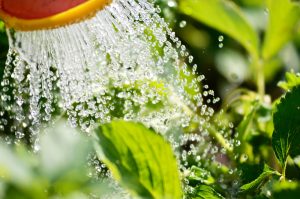
2: Watering Your Plant Wrong
Most people think their plant dies from not getting enough water. But, in fact, most plants dies from being overwatered. Too many plant owners buy a lush looking houseplant and pay it a lot attention by watering or spritzing it every day. This causes root rot.
Overwatering a houseplant prevents proper drainage which leads to root rot. Root rot causes a plant’s roots to turn mushy and brown due to lack of oxygen. Signs of root rot include the plant slowly wilting and the leaves turning yellow and falling off.
Most pot plants are sold in tiny pots so re-pot them into bigger ones right away. More soil holds more water and stays moist longer. Make sure the new pot has drainage holes in the bottom.
You should also try to water the plant less often. And when you do water, soak it thoroughly in the sink or with a pitcher. This wet-dry cycle encourages stronger roots and helps prevent root rot. If the soil gets so dry it won’t absorb water, set the pot in the sink and put the tap on a slow trickle for about 15 minutes.
If your plant is already starting to suffer from root rot remove it from the soil and wash the roots clean. Cut the roots back to remove the diseased tissue and repot the plant in fresh soil after cleaning and disinfecting the container.
A plant is truly dry and in need of water when the dirt is pulling away from the side of the pot. That is a telltale sign that your plant needs watering ASAP!
3: Too Much Fertiliser
When dead leaves and twigs decay, ecosystems recycle them into nutrients. But when a houseplant’s dead leaves fall they are thrown away. So we need to fertilise to replace what is lost. But too many people either fertilise too much or too little. This means the plant either gets too little nutrients or too much and burn the roots. Houseplants can also become over-fertilised over time as water evaporates and leaves the solids behind. An over-fertilised plant can wilt, even when it’s watered. The leaves may get soft like they’re made of cloth and the leaf tips can turn brown.
Most potting soil will come with plenty of organic material and/or added fertiliser so you won’t need to add fertiliser for a long time. When you do add fertiliser, make sure you follow all the instructions on the package and, when in doubt, use less than recommended. Ensure the type you use is specifically for house plants.
Choose a solid or time release fertiliser as these are less likely to burn the roots. Only fertilise when the plant shows signs of needing it – a lack of new growth, new leaves that are small and stunted, or new leaves that are pale with green veins.
Is a dusty, white or tan substance gradually accumulating in the plant’s tray? That is excess fertiliser and salts. Even tap water can slowly add some salts to soil over the months and years. Rinse the tray off every few months and you should be fine.
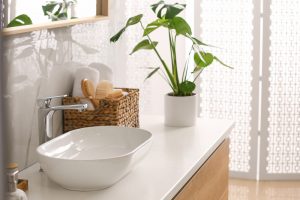
4: The Air is too Dry
Low humidity creates heat stress. The air in your home is the driest in winter and is especially damaging to parlour palms, ferns and orchids. They can lose leaves or develop brown streaks. If you live in a region with dry air or low humidity, choose plants that don’t need humidity. These include succulents and plants with woody stems.
Keep humidity-loving plants in well-lit bathrooms, where the air gets steamy every time you shower. These small rooms also get less drafty. Cluster houseplants together as plants raise the air humidity around them.
Home humidifiers are also good for humidity-loving plants, and are great for people too! The coolest room in the house is also the room that is the most humid, as is the coolest part of a warm room, like a windowsill, so try to cluster pants in these areas.
Setting plants in wide trays of water and gravel can humidify the air through evaporation.
5: Your Plant Has Gone Dormant
Plants who undergo trauma often go dormant. And many plants, including tropical plants like orchids, often go dormant seasonally. Unfortunately, dormant plants often look like dead plants and homeowners tend to throw them out. If a plant looks dead or dying, try trimming off the dead parts, give the plant a little love, and see what happens. Plants that go dormant will return on their own. Research the type of plant you own and see how long its dormant cycle lasts and how to care for it. Some plants need to be kept cold while dormant then brought back into the warmth at the end of the cycle. Others need to remain in their same environment. Make sure you know the particular needs of your plant.
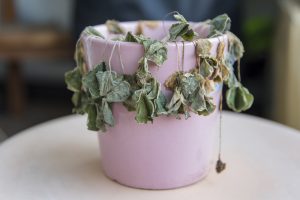
5: You Neglect Your Plant
Unfortunately, for a lot of us, the reason our plants die is neglect. It is very rarely deliberate. Our lives are busier than ever and it simply just gets in the way sometimes. Thankfully, most houseplants only need to be watered once a week. And most species are hardy enough to survive if you skip a watering. But everyone should be able to find time, once a week, to water their plants. Being a responsible plant parent means ensuring you carve out 15 minutes of your week to ensure you plants get plenty of water and you take time to also check their lighting conditions, coil conditions, and the nutrient levels of the soil.
6: Different Plants Have Different Needs
While every plant needs the basics of water, light, air, and soil to live, plants need different amounts of these to survive. How much light, air, water and soil you give to each plant will depend on what species they are. Some plants need to be moist at all times, others need the soil to dry out completely between watering. Air plants don’t need any soil to survive, orchids and pitcher plants need specialised sphagnum moss, while parlour plants are happy in regular soil. Some plants need bright, direct light to thrive, while others grow best in the shade. Before buying any new plants, look at the lighting conditions where you want to place them, research the type of plants that suit that spot and go from there.
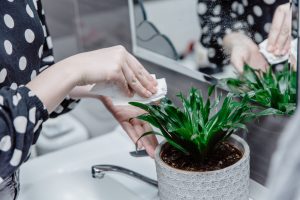
7: Dusting Your Plants
Did you know you have to dust your plants? Just like everything else in your home, your plants can gather dust. But unlike your shelves and appliances, dust can actually kill your plants. Your plants use their leaves to soak up sunlight. They turn this light into sugars and energy to grow and live. This is called photosynthesis. When dust accumulates on the leaves of plants, it prevents them performing this vital photosynthesis and so your plants will being to droop and wilt.
You need to regularly clean the surface of the leaves with a soft, damp cloth. This is not only the best way to get your plants looking pretty, it also gives them the best chance to take in all the sun they can.
Cleaning your plants also allows you to get rid of any dead leaves or stems. Leaving dead and rotten stems or leaves can cause infections in the healthy ones. So it is necessary to get rid of the dead parts as quickly as possible. You should also remove any weeds you see, as well, so they don’t strangle your plant.
8: Improve Air Quality
While plants help clean the air, they also require clean air to survive and thrive. Clean, pure air is the best for all living things. Polluted or contaminated air is the biggest reason for stunted growth and root growth issues in plants. Do your plants face the road? Are you a smoker? Do you smoke around your plants? Are your plants in the kitchen where they are more likely to be exposed to contaminates, hot air and smoke? Try to rotate them outside or to other areas of the house frequently, so they have time to recover. And be sure to wipe their leaves regularly, to ensure there is no build up of contaminates on the leaves to prevent photosynthesis.
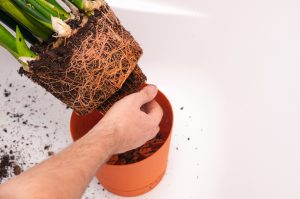
9: Cramping and Shock
Just like humans, plants can suffer from cramping and shock. Cramping occurs when plants have outgrown their current pots. Despite their regular watering and feeding, your plant may be struggling to thrive. When you water it, you may notice that water is seeping out of the drainage holes immediately after watering. You just need to purchase a bigger pot, add some fresh soil, and you’ve give your plant some room to breathe.
Shock occurs when you move your plants around your home. While moving and rotating your plants is important, your plants can experience shock from rapid changes in temperature or light. This can lead to a sudden loss of leaves. This is especially the case if your are moving balcony plants indoors during the winter. Start by placing them in the new location for a few hours then returning them to their previous spot. Gradually increase this time in the new location until the plant is ready for its complete transition.
10: Plant Disease
Plant disease can also cause a plant to suddenly die. Here are some common plant disease and how to identify them.
Fungus
Fungus can be identified as brown patches on the stems and leaves of a plant. This indicates dieback, also known as fungal disease. Make sure you isolate the affected plant or plants so you don’t end up spreading the disease to all your plants. Remove all fungus-ridden leaves and stems and treat the plant with an antifungal solution.
Spider Mites
Do you see small webs around the leaves of your houseplants? This indicates the presences of spider mites. These a small arachnids that cause damage by feeding on leaves. If you spot the signs of spider mites, isolate the plant to prevent it spreading to your other plants. Put the plant in the sink and hose it down to remove the mites. Then use an insecticide soap to combat any lingering mites and spritz the plant daily with water, as spider mites only thrive in dry conditions.
Scale
Yellowing or wilting leaves can be a sign of many different problems in plants. But if wilting leaves are coupled with small, dome-shaped shells on the leaves, the plant is most likely suffering from a scale infestation. These insects suck the sap and moisture out of plants, killing them in the process. You can scrape the scale off the leaves with a table knife or a similar object but if the infestation is bad you will need to completely remove the infected parts of the plant and then treat it with an insecticide.
Powdery Mildew
Noticed a powdery-like substance on the leaves of your plants? It is likely that you have powdery mildew. This is a fungal disease that will eventually kill your plants. You need to remove all infected parts of the plant and relocate it to an area with better air circulation.
Whiteflies
Whiteflies are another common pest that suck the sap from a houseplant. This causes the leaves to yellow and die. A large whitefly infestation will kill a plant and infect others around it. As a result, you will need to manually remove the insects by pulling, hosing, or even vacuuming them off the plant. Make sure you check every part of the plant, especially the underside of the leaves, where the whiteflies like to lay their eggs. Finish by applying a very strong insecticide soap to stop the flies returning.
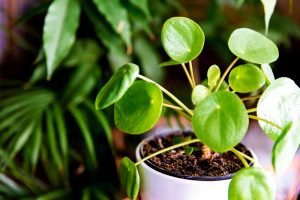
11: Choosing the Wrong Plant
If you can’t work out why your plant is struggling to thrive, it could be that you’ve simply picked the wrong variety. Some plants need to be in certain spaces to thrive, while others will thrive anywhere. And some plants simply cannot live as houseplants or pot plants. Always research your plants before you place them in your home and before you choose where to place them. Make sure you take their light and airflow needs into account. By providing them with the right conditions, you will always have the most amazing, thriving houseplants.
Looking for the perfect houseplant for your home? Want lush greenery and stunning flowers for your home? Come in store and explore Aumann’s range, today!

